Textile Art – a tactile interface in a digital world – MA Dissertation
Stacey Harvey-Brown – November 2013
“… one of the great achievements of modern art and philosophy…has been to allow us to rediscover the world in which we live, yet we are always prone to forget.” Merleau-Ponty1
Touch is, for Aristotle, “the most basic sense of animate being”;2 tactility the “primordial sense in which the body’s interiority is constituted”3 according to philosopher Donna Irigaray, who further asserts that neither consciousness nor seeing is possible without the sense of touch.4 However, the peculiarly Western fixation on visual and auditory senses has led to a ‘forgetting’ of other senses, systematically undervaluing them. Yet it is all the senses that together give us our understanding of the world in which we live and with which we interact, from the first grasps of a baby’s hand through to our dying day.5
As a weaver, my practice is rooted in the exploration and sharing of tactile properties inherent in textiles through a selection of materials, structures and subsequent processes. This essay considers the nature of tactility in the use of contemporary textile art practice, investigating four artists whose varied approaches to haptic6 involvement with their audiences through their work opens up a dialogue of touch.
Experience is most often mediated through the senses: our skin is the place where we meet the world, and the world meets us; to touch is to be touched. But senses alone are not the whole story. Anthropologist Ken Wilber attests that combined with the somatic senses is a world of symbolism, concepts and language, commingled with spiritual belief which gives each individual their own separate view of the world and how it affects them as they live their lives.7 In art, it is the capacity to affect and be affected, that makes an experience memorable.
Bertrand Russell pointed out “it is the sense of touch which gives us our sense of reality”.8 We need to touch. In Western philosophy, the discipline of phenomenology was the first to treat material experience (perception, sensation and attention) as a serious concern and one which allowed for a “sense of immersion in the world.” 9 Frequently artists achieve this by using their hands to create their artworks through direct manipulation of material or through the use of tools.
In fine art, vision is still the primary encounter in many cases, especially in painting, photography and video, interpreted through each individual’s specific experiences-material, personal and cultural. Touch is often prohibited as an audience response, and comparatively few artists actively encourage it. Certainly, in instances such as fragile materials, touching would irrevocably damage artwork but there have been, and continue to be, artists who actively seek audience participation and physical engagement with their work. Interactive works often draw long queues from a public eager to immerse themselves in a physical experience and there are sound physiological reasons why we are attracted to tactile engagement in artwork. Pleasure in handling is “hard-wired” into human nature from babyhood onwards. In fact, “not to do these things contravenes our fundamental nature.”10
It has been suggested that the growth of digital technology is also fuelling this desire to touch and interact with the world physically. Our daily lives have been hugely impacted by electronic devices which use touch in an unconscious way, with our eyes and attention fixed to a screen rather than aware of the activity of our hands, even whilst using touch screens. “Human beings, like things, have become interfaces in a technological world”11, and along with that technology has come a notion of the compressing of time and space. Art can introduce us to a wider world allowing new insights and possibilities. Involving ourselves physically in an interaction with tactile artwork can slow us down, allowing time to breathe, engage and reflect. Art as a participatory experience can be “an environment into which the spectator enters bodily and experiences physically as well as mentally … Its intention is to involve and to awaken the spectator to the reality of his or her immediate emotions and experience” as sculptor Magdalena Abakanowicz explains.12 Heightened awareness alone, however, does not create the experiential affect that accompanies tactile interaction.
How important is the effect of tactility in our experience of art? The four artists I highlight have all chosen audience interaction through touch and textiles. Each investigates the relationships between themselves and their audiences through participation and feedback. Textiles are, by their ubiquitous presence in our lives, a familiar and comforting medium in which to explore ideas of haptic perception and participation with an audience. Ann Hamilton’s recent piece at Park Avenue Armory in New York is more an interaction, whereas Ernesto Neto encourages tactility by total immersion in his work. Rosalyn Driscoll’s medium of skin both attracts and repels as she commits to a total tactile engagement and feedback with her audience whilst Lia Cook is looking specifically at the neurological reactions of people who interact with woven textiles and incorporating those brain patterns into the woven work.
Ann Hamilton’s installation, The Event of a Thread at Park Avenue Armory, New York in 2012/2013, is a multi-layered, multi-sensate, interactive work which highlights her specific interest in the audience’s sensory experience. As she states, it is about “being in your body… inside the motion”.13
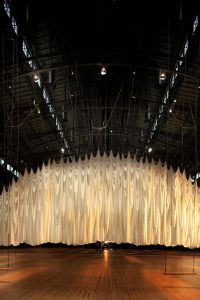
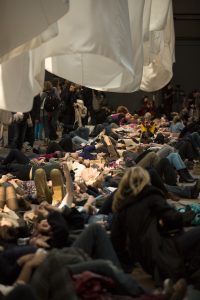
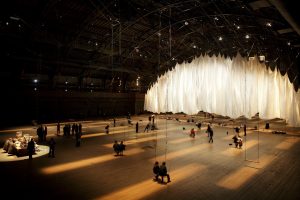
Figs 1, 2 & 3
One of her concerns is that changing technologies alter perception of time and distance. Time is integral to her work and she aims to create a state of between-ness, resetting our sense of time. Touch is another of the “central spines” of Hamilton’s work, stemming from her university weaving days and prompted by Anni Albers’ reference to the “touch and contact at the intersection” of warp and weft – intersections which themselves are points of ‘between-ness’,14 between elements of vertical and horizontal, between a singular element and the field.15 This relationship is the underlying structure of this piece and stems from singular events such as the daily ritual release of birds, the writing and reading performances which are ongoing, to the entire exhibit with its observers and participants enabling the work to live and take on its multiple identities and perceptions. The work is not necessarily about physically touching the cloth, but the interaction with the installation, engaging with other participants, and consciously utilising our somatic senses.
The multiple layers of participatory experience16 that Hamilton has constructed allows the audience to engage with the work through many different approaches.
Ernesto Neto’s work also has multiple readings, but the scale and materials invite introspection and a more intimate interaction as well as outward participation. Using a stretch translucent fabric, a polyamide tulle, he creates “a sculptural membrane whose semi-permeability attracts both tactile and visual interaction”.17 These membranes are often stretched over skeletal forms to create architectural environments around, through, and in which visitors can interact, view, or physically experience the work, themselves, and other visitors. In Neto’s own words, this “place of sensations…exchange and continuity between people” is designed to inspire “enquiry into our relationships with limits and thresholds” through “a shared field of collective experience and action.”18
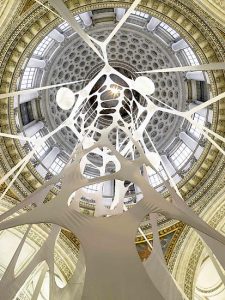
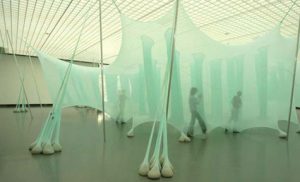
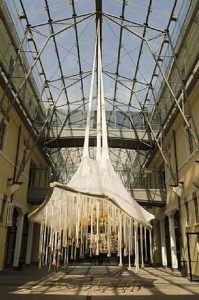
Figs 4, 5, 6
In common with Hamilton, Neto creates time to “breathe and think”, a creative, contemplative space of transparent layers and tubes. Both artists’ work effectively renegotiates relationships between complete strangers as they interact in a shared communal experience in a physical translation of Merleau-Ponty’s principle of embodied perception.
Whilst Hamilton and Neto employ a strong visual aesthetic, Rosalyn Driscoll is committed to a primarily tactile approach to her work. Using cowhide as a textile allows her both to repel and attract her audience at the same time, with the sensuousness of the illuminated and semi-transparent membrane, pulling people in and raising awareness of the nature of skin.
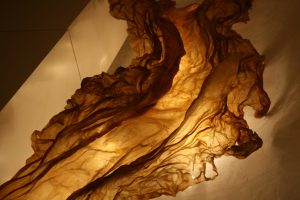
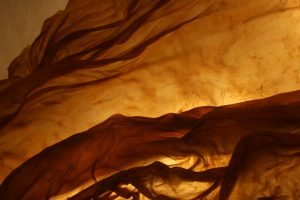
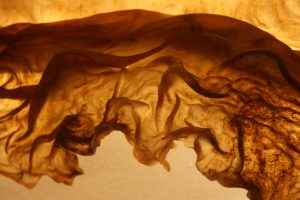
Figs 7, 8, 9
Driscoll works specifically with her audience in mind, actively requesting feedback and encouraging her work to be touched in an intimate way. Unlike Neto’s work, where the audience responds in a joyful, playful way to touching the work, Driscoll’s sculptures engage the physical, reflective and intellectual (and sometimes disturbing) elements of play, stimulating consideration of how we use our body and our sense of touch to negotiate the world. Driscoll’s skin artwork is entwined with the body, with hollow, wrinkled, amorphous body shells and abstracted forms that link to different body parts. To explore these blindfold requires contact and movement – haptic perception- the kinaesthetic nature of active touch, allowing one to realise how hands and vision separately can build up different images of a sculpture. Conscious touch is vitally personal, whilst vision can mentally abstract you from the experience, intellectualising and rationalising your emotions rather than directly feeling them.
Compared to Hamilton and Neto, Driscoll highlights the emotional as well as physical touch, an ‘aesthetic touch’,19 a way for her art to become more embodied both for her and the interacting audience. Using skin as a textile is a double referent, as textiles commonly double as a skin or membrane forming a boundary, both material and metaphorical, and a very real, tangible point of contact between the body and the outside, or “between self and ‘not-self'”.20 The power of skin as a physical ‘cloth’ in these sculptures heightens the ambiguity of boundaries and produces highly complex relationships between artwork and perceiver, subject and object.
Weaver Lia Cook21 approaches tactility via scientific investigation of perception through cloth. As textile artist Maxine Bristow states “The immediacy of touch… makes [textile] a potent vehicle of expression”.22 She goes on to suggest that it is the “embodied non-verbal materiality of the medium” that makes it so. John Potvin, in his article ‘Lost in Translation? Giorgio Armani and the Textualities of Touch’ agrees . “Definitely seductive and decidedly sensual, textiles insinuate and initiate a markedly different experience than vision can provide for the embodied subject in its relationship to the world.”23 The affect that looking at textiles has on our brains is astounding, let alone what happens to our neural activity when actively touching them. Neurologist Oliver Sacks explains, “there is increasing evidence from neuroscience for the extra-ordinarily rich inter connectedness and interactions of the sensory areas of the brain”24 and Cook’s collaboration with neuroscientist Dr Joann Peck maps brain activity that occurs when people view a woven textile portrait (hers) in comparison with its photographic equivalent.
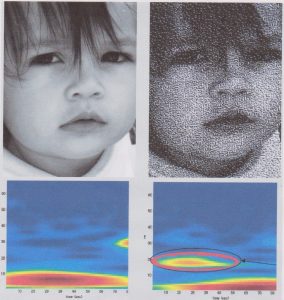 Fig 10
Fig 10 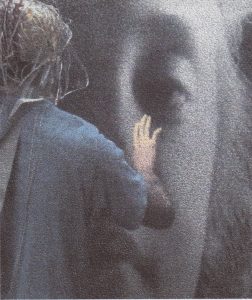 Fig 11
Fig 11
They discovered that viewing the weaving triggered emotional response connections in the viewer’s brain which were absent when viewing the photograph. This led to further research into responses when viewers were physically allowed to touch the woven portraits, which showed correspondingly greater neural activity.
In this instance, touch has become an instrument of scientific exploration, and weave its embodiment, endowing textile with a potency that both expresses the reciprocal relationship between subject and object and invests it with cultural and artistic meaning.
Claire Pajakowsa suggests “textiles are culturally situated on the threshold between the functional and the symbolic.”25 It is a liminal position, constantly shifting from skin to boundary, and from protection to exploration. Weaving is a means to experiment with surfaces and textures, and Jessica Hemmings talks of the “‘weaver’s sensibility’, a way of approaching the visual and material world that guides thinking far beyond the construction of cloth.”26 My own work seeks to exploit these attributes with explorations into tactility through material, structure and surface relief, involving audience participation of touch. The four artists I have highlighted each bring different aspects to the fore, all combining to engage the audience both experientially and intellectually. Textiles have the capacity to bring fundamental issues to a receptive audience through their familiarity in our everyday lives, and remain a major component in our lives both despite and because of the advance of technologies. As John Potvin writes, “textiles …bridge … worlds as they fuse new technologies with tradition.”27 Cook’s work, in particular, utilises highly sophisticated digital technology with the traditional craft of weaving, both in the scientific instruments used, but also in the digital loom that she employs.
In conclusion, touching is the body asking questions and making connections. Our relationship with the world is based on all our senses, of which touch is a major, albeit under-estimated, part. Touch is a vital component in our interaction with ourselves, others and the outside world. Textiles, along with the somatic senses, are imbued with symbolism, concepts and language, which can be both a strength and a weakness. The textile artist, by moving away from the utilitarian, is perhaps well situated to challenge and explore the role of tactility in contemporary society.
Notes
1 Merleau-Ponty,M.,(1948)[Trans. Oliver Davis, 2004], p.6
2 ‘De Anima’, The Works of Aristotle, Book II (2), 413b (1931)
3 Vasselue, C., (1998) p.67
4 Ibid p.12
5 See Dissanayake, E.,(2000)
6 Haptic perception combines kinaesthesis, the awareness of tensions inside the body, made possible by neural receptors in muscles, tendons, and joints, and tactility, the exploration by touch of the shape of physical bodies.
7 Wilber, K., (1991)Eye to Eye – The Quest for the New Paradigm, Boston: Shambhala Publishing Inc. cited in McCullough, M., (1996), p39 See, among others, Dissanayake,E., (1988, 1992, 2000)
8 Russell, B., (1925) The ABC of Relativity,New York: Harper & Bros. cited in Montagu, A., (1986), p.13
9 Merleau-Ponty,M., (1964) cited in Paterson, M., (2007), p.88
10 Dissanayake, E.,(2000) pp.101-102
11 McCullough, M., (1996) pp.233-234
12 Rose, B. (1994), pp.120 & 125
13 Art 21 video with Hamilton (2013), Accessed 6th September 2013
14 Art 21 video with Hamilton (2013), Accessed 6th September 2013
15 Simon, J., (2002) p.28
16 This can be i) passive observance from the sidelines; ii) passive active, lying under the billowing cloth, listening to the murmuring voices of actors reading aloud through a radio wrapped in a paper bag in a heightened by hypnotic awareness of yourself and others; iii) active observer wandering around the installation stepping over and around people, watching and listening; or iv) active immersion, swinging on the swings, making the cloth respond.
17 Hayward Publishing (2010), p.11
18 Ibid, p.8
19 “Aesthetic touch means using touch to explore textures, forms and spaces for their qualities and effects… focus[ing] on the knowing and creativity embedded in the sense of touch, especially the touch involved in making, knowing, and understanding works of art, whether through actual touch or tactile imagination. This kind of touch is complex and subtle. …touch always includes more than mere contact and more than just hands, creating effects well below the skin and far beyond the hands. The whole body is engaged, from surface to depths…” Driscoll, R., (as yet unpublished), p2.
20 Hemmings, J., (ed) (2012), p.46
21 in collaborations with The Schiller Lab for Affective Neuroscience and Mount Sinai School of Medicine. See Appendix 3 for scientific outcomes.
22 Bristow, M., ‘Textile as Silent Witness’ in Hemmings, J., (ed) (2012) p.47.
23 Potvin, J.,’Lost in Translation? Giorgio Armani and the Textualities of Touch’ in Alfoldy, S., (ed) (2007), p.83
24 Sacks, O.W., ‘A Neurologist’s Notebook: The Mind’s Eye – What the Blind See’, New Yorker, 28 July: 55), cited in Paterson, M.,(2007) p.56
25 Pajakowsa, C., (2005) p.223
26 Hemmings, J., (2012b)p.8 “I understand the weaver’s vision to be just this, an ability to work within the discipline and logic of weaving, while remaining alert to serendipity and trusting creative intuition.”
27 Potvin, J.,’ Lost in Translation? Giorgio Armani and the Textualities of Touch’ in Alfoldy, S., (ed) (2007), p.83
List of Illustrations
Fig.1 Ann Hamilton ‘The Event of a Thread’, Park Avenue Armory, New York 2012/2013 Ann Hamilton Studio (photo: Al Foote III 05/01/2013)
Fig.2 Ibid., (photo: Thibault Jeansor 10/12/2012)
Fig.3 Ibid., (photo: Thibault Jeansor 10/12/2012 (Figs 1 – 3 kindly supplied by Ann Hamilton Studio)
Fig.4 Ernesto Neto, Leviathan Thot, 2006 Polyamide tulle, polyamide fabric, styrofoam balls 5300 x 6200 x 5600 Installation view Panthéon, 35th Festival d’Automne, Paris from Ernesto Neto The Edges of the World Hayward Gallery, London (photo: Marc Domage Ernesto Neto The Edges of the World. London: Hayward Publishing, p110)
Fig.5 Ernesto Neto, Celula nave (It happens in the body of time, where truth dances), 2009 Polyamide tulle, polyamide fabric, polyamide stockings, aluminium tubes, sand, styrofoam pellets and rubber balls, 20000 x 2400 x 475 Installation at the Museum Boijmans Van Beuningen, Rotterdam. (photo: Bob Goedewaagen Ernesto Neto The Edges of the World. London: Hayward Publishing, p134)
Fig.6 Ernesto Neto, While nothing happens. 2008. Polyamide tulle, spices, plywood, sand 1200 x 760 Installation view at MACRO, Rome. (photo: Ernesto Neto from Ernesto Neto The Edges of the World. London: Hayward Publishing, p127)
Fig.7 Rosalyn Driscoll, River of Hades: Phlegethon 2011. Cowhide, light. Installation view at GV Art, London. (photo: Stacey Harvey-Brown [2013]
Figs.8 & 9 Rosalyn Driscoll, River of Hades: Phlegethon 2011. Cowhide, light. Detailed views at GV Art, London. (photo: Stacey Harvey-Brown [2013]
Fig. 10 Fabric Task EEG for TREND Program – neurological study of brain activity. Left image – photo of Cook as a child – accompanying EEG underneath of subject viewing the photo. Right image – woven image of Cook taken from photo – accompanying EEG showing increased emotional response to woven image. (Image kindly provided by Lia Cook.)
Fig.11 Lia Cook “Facing Touch” 2011 54” x 51”, Cotton, Rayon. Woven. {photo: Lia Cook [2011]) Collection of Chicago Art Institute
2019 Amendments and additions to 2013 list below of web-sites accessed when researching the selected artists. Some of the links provided in the essay of 2013 are no longer valid. As of 1st January 2019 the following links provided in the essay no longer work. These are:
Ernesto Neto Festival Brazil, Southbank – no longer valid Lancia interview – no longer valid
Rosalyn Driscoll Art of Touch catalogue link – no longer valid. Art in Touch Sensory Sites link – no longer valid. This link will take you to the relevant CenSes site http://philosophy.sas.ac.uk/centres/censes NB (http://thecenses.org/about is not a valid link. The current website belongs to a different organisation.)
GV Art is now :
http://issuu.com/gvart/docs/gv_art_-_generation_catalogue
Additional links to the exhibition: http://www.wildculture.com/article/generation/1285
http://www.trebuchet-magazine.com/generation-gv-art/
Lia Cook Design Gallery, Wisconsin – no longer valid Please use: http://www.liacook.com/
2013 Web-sites accessed when researching the selected artists – Ann Hamilton, Ernesto Neto, Rosalyn Driscoll, Lia Cook PLEASE use in conjunction with the list above.
ANN HAMILTON (All accessed 6th September 2013)
New York Times review of the Armory exhibition of 6th December 2012 http://www.nytimes.com/2012/12/07/arts/design/ann-hamilton-at-the-park-avenuearmory.html?pagewanted=2&_r=1&
The Economist’s review of 18th December 2012 http://www.economist.com/blogs/prospero/2012/12/visualart?utm_source=wordfly&utm_medium=email&utm_campaign=12.12.20Newsletter)all&utm_conte nt=version_A
Online magazine, Art Critical, review of 20th December 2012 http://www.artcritical.com/2012/12/20/ann-hamilton/
Art 21 Video of The Event of a Thread exhibition with interview with Ann Hamilton (4:58) Published 19th April 2013 http://www.youtube.com/watch?v=1fJ4umqXGjM
Modern Art Notes podcast (2:53 – 40:04) http://soundcloud.com/manpodcast/ep58
ERNESTO NETO (All accessed 7th September 2013)
The Economist’s article 7th September 2006 http://www.economist.com/node/7879954
The South Bank Centre website for the Festival Brazil and Ernesto Neto’s exhibition The Edges of the World 2010 http://festivalbrazil.southbankcentre.co.uk/ernesto-neto/
Interview with Ernesto Neto 14th June 2013 http://www.lanciatrendvisions.com/en/article/take-your-time-interview-with-ernesto-neto
ROSALYN DRISCOLL (All accessed on 16th September 2013)
Rosalyn Driscoll website http://rosalyndriscoll.com/
one page catalogue The Art of Touch exhibition, 20 – 24 November 2007, at the 4th International Conference of Enactive Interfaces, Grenoble, France http://acroe.imag.fr/enactive07/artoftouch.php
Art in Touch Sensory Sites Group exhibition 20th August 2012 http://www.artintouch.co.uk/2012/08/20/rosalyn-driscoll/
Video documentatino of three of Driscoll’s tactile sculptures narrated by the artist and describing her evolution from visual artist to tactile engagement with the audience. Filmed and edited by Zach McDonald, 2008 (5:31) http://vimeo.com/58102786
Courtauld Institute of Art review of Reflections on the Art and Science of a Neglected Sense exhibition held at the Courtauld Institute May 2008 – Jan 2009 http://www.courtauld.ac.uk/researchforum/projects/sculptureandtouch.shtml
GV Art Gallery website for Generation where the catalogue can be viewed and downloaded. http://www.gvart.co.uk/generation-rosalyn-driscoll-and-tereza-stehlikova-26-september-5-october2013.html
LIA COOK (All accessed 17th September 2013)
Lia Cook website http://www.liacook.com/
Design Gallery, Wisconsin Weaving and Innovation exhibition page includes short video with Lia Cook (1:14) http://www.designgallery.wisc.edu/exhibits/Lia%20Cook/
Ruth Davis Design Gallery catalogue for the Weaving and Innovation exhibition. http://www.designgallery.wisc.edu/exhibits/Lia%20Cook/LiaCookCatalog.pdf
Bridge 11 Exhibition page Feb 4 – May 13th, 2012 http://www.crafthouston.org/exhibition/bridge-11-lia-cook/
American Craft Council article Kaminsky, C., ‘Lia Cook: On the Loom of Contradiction’, American Craft Magazine, Feb/March 2010 http://craftcouncil.org/magazine/article/lia-cook-loom-contradiction
MODA Madison, blog review of Weaving and Innovation exhibiition, Morrow, A., 6th Feb 2013 http://modamadison.com/2013/02/06/lia-cook-Weaving-and-innovation/
Craft in America video series, Episode 19, Crossroads. Aired PBS 16th November 2012. Explores intersections of craft, culture, science and technology in American craft with artists including Tanya Aguiniga, Lia Cook, Clary Illian, Warren MacKenzie and Jeff Oestreich. http://video.pbs.org/video/2300857107/
APPENDIX 1 GLOSSARY OF TERMINOLOGY
Haptic Relating to the sense of touch in all its forms, including:
Proprioception Perception of the position, state and movement of the body and limbs in space. Includes cutaneous, kinaesthetic, and vestibular sensations.
Vestibular Pertaining to the perception of balance, head position, acceleration and deceleration. Information obtained from semi-circular canals in the inner ear.
Kinaesthesia The sensation of movement of body and limbs. Relating to sensations originating in muscles, tendons and joints.
Cutaneous Pertaining to the skin itself or the skin as a sense organ. Includes sensation of pressure, temperature and pain.
Tactile Pertaining to the cutaneous sense, but more specifically the sensation of pressure (from mechanoreceptors) rather than temperature (thermoceptors) or pain (nociceptors).
Force Feedback Relating to the mechanical production of information sensed by the human kinaesthetic system. Devices provide cutaneous and kinaesthetic feedback that usually correlates to the visual display.
(From The Senses of Touch: Haptics, Affects and Technologies Mark Paterson, 2007, Oxford, New York: Berg)
Somatic Of or relating to the body, especially as distinct from the mind
From The Oxford English Dictionary, Della Thompson (Ed.), 1996, Oxford, New York: Oxford University Press
APPENDIX 2 – Ann Hamilton the event of a thread pdf
Ann Hamilton the event of a thread, 2012 Park Avenue Armory, New York, NY Photo credit: Al Foote III Commissioned by Park Avenue Armory Courtesy of Ann Hamilton Studio
Commissioned by the Park Avenue Armory for the 55,000-square-foot Wade Thompson Drill Hall, the event of a thread was on view from December 5, 2012 through January 6, 2013. Set into motion by visitors, a field of swings, a massive white cloth, a flock of homing pigeons, spoken and written texts, and transmissions of weight, sound, and silence animated the hall’s particular civic and social space.
The title comes from Anni Albers, who wrote that all weaving traces back to “the event of a thread.” The intersections of reading, writing, and singing bracket the open field of the hall, which is bisected by a massive white cloth—suspended through ropes and pulleys to 42 swings—that registers the back and forth, up and down, pull and lift of body weight. The silk’s liquidity registers the combined velocities and accelerations of the field of swings. The shifting weather of the white cloth is generated through collective action.
At the threshold of the hall and facing a flock of caged pigeons, two readers, seated at a wood table, read aloud from scrolls that slowly amass below on the floor. Their address is to the birds; part explanation, part impossible communication. Transmitted to radios in paper bags, their voices are hand-carried throughout the space by visitors. On the hall’s opposite end and facing away from the white cloth, a seated writer responds to the conditions in the room, the radio transmissions, and the space as seen in a mirror reflection whose rotating view is determined by the cloth’s movement. They write letters addressed to qualities, emotions and places far away—Dear Far, Dear Near, Dear Sadness, Dear Weight, Dear Time, Dear Here.
As the hall is bracketed by reading and writing, the interval of the day is bracketed by live song and its recording. At day’s end, a vocalist on a balcony serenades the pigeons when released to flight. Composed by David Lang, their plainsong is cut live to vinyl lathe. A different singer on each successive day accretes, in turn, an additional record, and in time, a “chorus.”
the event of a thread is made from crossings of the near at hand and the far away: it is a body crossing space, is a writer’s hand crossing a sheet of paper, is a voice crossing a room in a paper bag, is a stylus crossing a groove, is a touch being touched in return. It is a flock of birds and a field of swings in motion. It is a particular point in space at an instant of time.
APPENDIX 3 ROSALYN DRISCOLL
Biography
Rosalyn Driscoll is an American sculptor who investigates the experience of the body and the somatic senses through sculpture, installation, photography and collage. Her work has been exhibited in the US and Europe, and receives awards and fellowships from the Dartington Hall Trust, UK; New England Foundation for the Arts, Massachusetts Cultural Council; and Helene Wurlitzer Foundation of New Mexico.
She is a member of Boston Sculptors Gallery and Sensory Sites, an international collective based in London that generates collaborative exhibitions, installations and research to explore multi-sensory perception and bodily experience.
Her deep engagement with the body, touch and perception has led to presenting worldwide at conferences for neuroscientists, engineers, philosophers, designers, art historians and people involved with the body and disabilities. She has written numerous essays for books and journals and is writing a book, By the Light of the Body: The Somatic Senses in the Visual Arts.
Reproduced with permission from her website www.rosalyndriscoll.com Accessed 26th September 2013
Artist’s Statement
I begin with the feeling of being a body, and the ways I am affected by what I see and touch. I focus on the somatic senses of touch, movement and sensation-my own and my viewers’-to plumb the inner dimensions of experience, be they ‘physical, psychological or spiritual’. The artworks are constructions ranging from small enough to cradle to large enough to enter; they use a variety of sensuous materials rich in expressive qualities and tactile appeal, now also integrating light, motion, neon and video into their meaning and structure. Central to my work is the effort to transcend the dichotomies of outside and inside, sight and touch, mind and body, and self and world.
Reproduced with permission from the catalogue accompanying Generation, an installation by Rosalyn Driscoll and Tereza Stehlikovia at GV Art Gallery, 49 Chiltern Street, London, 26 September – 5 October 2013.
APPENDIX 4 – LIA COOK
BRIDGE 11: LIA COOK
FEBRUARY 4, 2012 — MAY 13, 2012 IN THE LARGE GALLERY Saturday, May 12, 2:00 PM “Navigating the Maze: Neuroscience and Fiber Connections” Lecture by Lia Cook at the Museum of Fine Arts, Houston, Brown Auditorium Houston Center for Contemporary Craft (HCCC) presents Bridge 11: Lia Cook, a solo exhibition of the work of internationally recognized fiber artist, Lia Cook. The exhibit presents large-scale woven images of human faces and introduces several works from a new body of work based on the artist’s recent art-neuroscience collaboration. HCCC Curator, Anna Walker, describes the significance of the exhibition: “Arguably one of the pioneers of the modern fiber-art movement, Lia Cook was one of the first people to utilize a digital jacquard loom as an art tool in the 1980s. HCCC is thrilled to host an exhibition of an artist as important to the history of studio craft as Cook, and we are especially pleased to do so during Fotofest 2012, the largest and longest-running international photography festival in the U.S. Thinking of her work in relation to photography provides visitors with an opportunity to recognize this medium as part of her process, as well as to consider her use of focus, scale and portraiture in the final works.”
Cook’s current practice incorporates concepts of cloth, touch, and memory. With her use of a digital jacquard loom, she weaves the images and creates monumental works that blur distinctions among computer technology, weaving, painting, and photography. Informal family snapshots, which offer intimate information and shared history, are frequently a starting point for her woven images. From a distance, each work paints the distinct and compelling features of a face. However, as the viewer comes closer, the “pixels” of the image dissolve into pointillist fields of individual threads.
In her new body of work, Cook was inspired by her participation in TREND (Transdisciplinary Research in Emotion, Neuroscience and Development), a 2010 spring residency at the University of Pittsburgh School of Medicine. During that time, she collaborated with Greg Siegle, a PhD professor of psychiatry, to collect computer data in real time and map the human brain as it responded to the stimuli of Cook’s woven faces. About the process, the artist said, ―We tried many different approaches using Electroencephalography (EEG), Pupil Studies, EyeTracking and functional Magnetic Resonance Imaging (fMRI). The subjects did a variety of tasks. In one example, they compared the woven image with a photograph of the woven image with the original tapestry itself. We could see different responses in the brain in visual images and found some evidence of my original idea that the woven image evoked a different kind and/or intensity of emotional response.
In her neuroscience-inspired body of work, Cook overlays her woven portraits with colorful lines that represent the data she collected. These linear patterns are both informative and visually inspiring to the artist. In essence, she has physically imbedded the portraits with scientific information.
A resident of Berkeley, California, Cook has been a Professor of Art at the California College of the Arts since 1976. She has exhibited widely across the United States, as well as in Australia, China, France and Ireland, among other countries. Her work can be found in many permanent collections, including that of the Metropolitan Museum of Art; the Boston Museum of Fine Arts; the Racine Art Museum; and the National Museum of American Art, Smithsonian Institution. Cook has also been the recipient of many prestigious awards and special recognitions, among them a French Fellowship from the National Endowment for the Arts, a Master of the Media for Fiber from the James Renwick Alliance, and a Distinguished Alumnus Award for the University of California.
Accessed http://www.crafthouston.org/exhibition/bridge-11-lia-cook/ 17th September 2013
REVIEW: LIA COOK AT THE MOMA, MADISON
February 6, 2013 Lia Cook: Weaving and Innovation story and photography by Alyssa Morrow
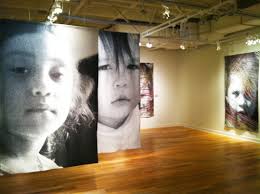
Artist Lia Cook visited the UW campus last Friday, bringing her recent work to Madison. Lia was featured at the Design Gallery in the Human Ecology building for her exhibit Weaving and Innovation. The title of the exhibit was a perfect fit, as Lia’s large woven portraits translated an innovative statement of the connection between science and the arts.
Lia’s art intertwines weaving, photography, media and science into large woven portraits. The subjects of these portraits are individual faces, each being more unique than the next. She creates these pieces on a large electric loom, where she can hand guide the threads to form the image. But Lia’s most prominent artistic touch comes from the presence of the emotional response in each image: With the help of neuroscientists, she has captured images of neural responses in the brain to emotional reactions. She then integrates these neural images in her pieces to emphasize the emotional response to woven images.


The first piece of Lia’s [left] that struck me was Mona Lia, one of the most magnificent pieces at the exhibit. Like most of the woven pieces shown, Mona Lia was woven from cotton and rayon fibers. In this piece, Lia captured images of neural fibers from her own brain and included them as part of the image.
The second work [right] that seemed popular among the crowd was Iteration Series. While talking to Lia about the piece, she explained, “All of these images are the same, but viewers say that each image triggers a different emotional response.” She achieves this flux in emotional response by using various colors and patterns.
Accessed 17th September 2013 http://modamadison.com/2013/02/06/lia-cook-weaving-and-innovation/
APPENDIX 5 Stacey Harvey-Brown
Artist’s Statement
My work is about tactility and the space between skin and the ‘other’, whether external or internal to the subject. My work has two main research areas, that of the technical aspect which would speak to an audience with knowledge of weave and textiles, and of an overarching theme of connections – between us and the outside world, through the medium of the skin, how the space between our skin and the ‘other’ leads to many different responses, that of sensation, emotion, spirituality (sometimes) and awareness of ourselves, our position in the world (both physical and metaphorical) and our relationship to the world outside of our skin, affecting us in such a way that we question that relationship and ponder our connectivity with the world.
Through the philosophical grounding of phenomenology and affect theory, my thinking hinges on the liminal space between thinking and action, not touching and the point of touch, anticipation and the dawning of awareness. This whole approach has stemmed from a desire to investigate the role of tactility in an increasingly digital world, and the apparent decreasing of the importance allocated to touch. Serres’ contention is not that the digital has eroded our understanding through our senses, but that the development of language did that. Now science is taking the place of language through knowledge that is more objective, abstract and mathematical than the social connections of the past, thereby reducing even more our sensory input to our meaningful lives.
As a weaver, I am constantly using my tactile sensibilities in creating cloth. Touch is both a conscious and unconscious part of my artistic vocabulary. Material and medium is important to me and textile is a familiar conduit to allow exploration of perception, emotions and sensations. Weaving is also a bridge between old and new technologies, employing as it does techniques which are known world-wide in many different cultures. In the industrialized world, we now have access to digital technology which increases our options and variety of approaches to weave, but the basic structures and understanding is the same whether the equipment is a simple pit loom or a digital computer-assisted electronic jacquard hand-loom.
In a world where we are increasingly harming nature by directly interfacing with it (i.e. stalactites being damaged through the chemicals in our skin interacting with the minerals, or attractive geological sites being eroded through the passage of millions of feet), I am interested in investigating ways of exploring our physiological need for tactility and physical connection with nature through creating installations where the work can be handled, and through being handled, questions arise about our interaction with the real world. Textile is a tactile interface, one with which we are all familiar. It can also be a conduit for enlarging our thinking about our interaction between ourselves and the world in which we live.
APPENDIX 6 Related Sensory Centres, Artists, Resources
Accessed http://www.sensorystudies.org/of-related-interest/ 17th September 2013 (list amended) List reproduced with kind permission from Rosalyn Driscoll.
RESEARCH TEAMS, CENTRES, LABS AND INSTITUTES –
Touch and Well-Being Research, University College London
Amsterdam Centre for Cross-Disciplinary Emotion and Sensory Studies, Amsterdam, NL
Sensate, e-journal, Harvard University
Sensory Stories Project, Humanities Research Centre, University of York
Crossmodal Research Laboratory, University of Oxford
Sensory Ethnography Lab, Harvard University
Centre for Sensory Studies, Concordia University
CenSes : Centre for the Study of the Senses, University of London
The Sense Lab, Concordia University Cultures
Sensibles, groupe de contact FNRS/Universite de Liege
Megaprojects New Media, University of Western Ontario
The Network for Sensory Research, University of Toronto
Senses and Society, International Sociological Association Thematic Group TG07
SENSORY ART AND DESIGN
Frank Vodvarka, artist, designer
Janine Antoni, artist
Adam Chodzko, artist
Olafur Eliasson, artist
Laurent Grasso, artist
Diller + Scofidio, interdisciplinary design studio
Laurie Anderson, artist
Granular Synthesis, immersive art
Lundahl & Seitl, transdisciplinary artists
Blast Theory, interactive media art
Silvia Mercuriali, site-specific + experimental theatre, immersive performance
dreamthinkspeak, site-responsive works
Coney, immersive stories for playing audiences
Sensory Maps (Kate Maclean)
Mitchell Akiyama, composer, Montreal, QC
Gwenn-Aël Lynn, Chicago, IL
Punchdrunk, England, UK
Janet Cardiff and George Bures Miller, Germany and Canada
Multisensory Design, National College of Art and Design, Dublin, Ireland
Laboratory for Immersive ArtScience, platform for synesthetic media and sound spatialization
e-sense, building novel sensory augmentation devices
Portable Palace (Evelina Domnitch and Dmitry Gelfand)
Orph.us (Doug Fitch and Mimi Oka)
Petrified Unrest (Stefani Bardin)
Rosalyn Driscoll, sculpture and touch
Concordia Synesthesia Project
Wearable Absence
Spectral Sensorium (:::TeZ:::)
RESOURCES
The Senses, Tumblr.com
Bibliography: Synesthesia in Art and Science
Initiative for the Study of Material and Visual Cultures of Religion, Yale University
Sounding Out!: The Sound Studies Blog
Synesthesia Resource Center
The Sixth Sense Abcderium
Art Beyond Sight
Neuroanthropology
Percepnet
Philpapers – Perception
Accessed http://www.gla.ac.uk/schools/humanities/research/philosophyresearch/cspe/ 17th September 2013
The Centre for the Study of Perceptual Experience (CSPE) facilitates analytical philosophical and empirical research into the nature of perceptual experience. Our researchers often work in an interdisciplinary manner drawing on philosophy, psychology, neuroscience, psychiatry, and human computer interaction. Our personnel conduct and publish research, often based on the conferences, workshops, reading groups that we organise. We have research links to many research groups in the UK, Europe and North America working on the nature of perception and we frequently host academic visitors from around the world. Please see the links on the left for details of our personnel, projects, events, activities, research, postdoctoral opportunities, and how to visit and study at the CSPE.
Accessed http://thecenses.org/about/ 17th September 2013
The Centre for the Study of the Senses, or CenSes, is hosted by the Institute of Philosophy, School of Advanced Study, University of London. The CenSes pioneers collaborative sensory research across disciplines, drawing on the work of philosophers, psychologists, neuroscientists and anthropologists, connecting groups of researchers from different fields and sectors who can benefit from one another’s results. The overall aim is to achieve a coherent framework to accommodate the welter of recent findings that have revised our understanding of how the different senses contribute to our perception of the environment, and awareness of ourselves. New discoveries have shown us how the senses as traditionally conceived are not so independent of one another as was once thought, and much work is being carried out on cross-modal effects and multisensory integration. However, as yet, there is no underlying theory or conceptual framework in which to house the numerous findings. Such a foundational approach to sensory perception can only be carried out by well-informed researchers working in a wide-scale and interdisciplinary way. Our aim is to make this possible by setting up a number of sub-groups investigating key issues, including: how different senses are integrated and how they influence one another (cross-modal integration and influence); our sense of agency and bodily ownership; the special nature of the chemical senses; the objects of perception across different sensory systems; the nature of sensory deficits, sensory substitutions, and sensory extensions; how and to what extent cognition is involved in different sensory systems (cognitive penetration); and the individuation of the senses.
We fund workshops in these areas to encourage networks for further interactions and once a year we hold a major conference to bring together the results form each group to ensure cross-fertilization. The outcome is a comprehensive account of the nature of our sensory systems and the role of particular senses in perception. Forum in philosophy of mind and neuroscience As part of the Centre for the Study of the Senses, the Institute runs a Forum: a series of seminars covering recent philosophical and neuroscientific research on the nature of our sensory systems, covering aspects such as, but not limited to, multisensory integration and cross-modal influences, our sense of agency and bodily ownership, the objects of perception, sensory deficits, sensory extensions and sensory substitutions, the cognitive penetrability and individuation of the senses.
Accessed http://www.susangreenfield.com/science/screen-technologies/ 13th November 2013 For peer-reviewed literature on the potential of evolutionary neurological adaptations to the brain due to increasing interaction with digital technology.
